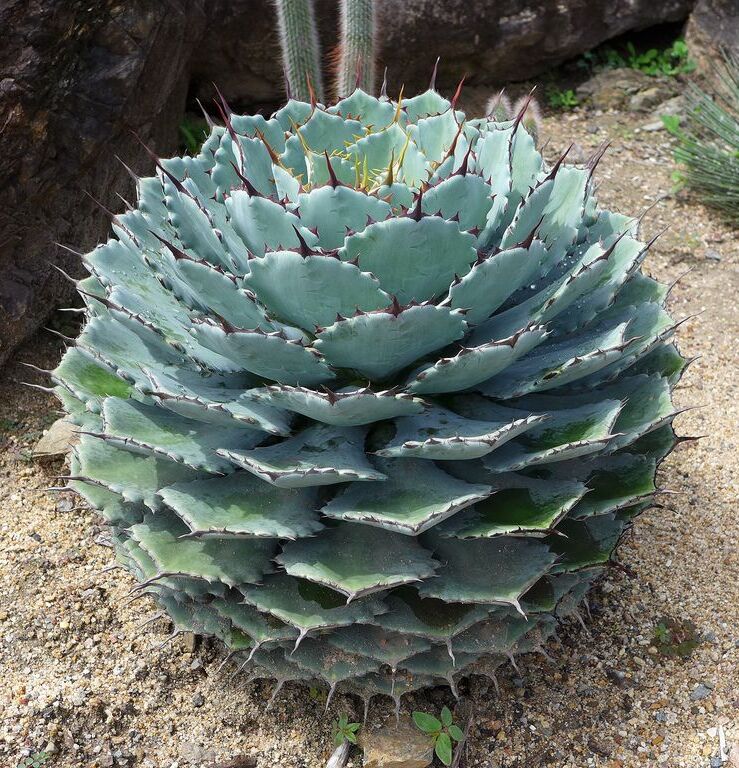Agave plants are a popular choice for landscaping and ornamental use, as well as for their use in the production of tequila, fiber, and other products. There are many different types of agave plants, each with their own unique characteristics and uses. In this article, we will explore some of the most famous types of agave plants and their uses.
1. Agave Tequilana (Blue Agave)
One of the most famous types of agave plants is the Blue Agave (Agave Tequilana). This type of agave is known for its large rosette of blue-green leaves and a tall central spike. The blue agave is primarily used for the production of tequila. The juice extracted from the heart of the agave plant, called the piña, is fermented and distilled to produce the popular Mexican spirit. Blue agave is also used to make other alcoholic beverages such as mezcal.

2. Agave Americana (Century Plant)

Another famous type of agave plant is the Century Plant (Agave Americana). This type of agave is known for its large size and the fact that it only blooms once in its lifetime, hence the name “century plant.” It has a rosette of green leaves with sharp teeth along the edges. Century plants are often used for landscaping and ornamental use, but also it has medicinal uses. The sap from the leaves is used to treat wounds and skin irritations, and the fibers from the leaves are used to make rope and other textiles.
3. Agave Attenuata (Fox Tail Agave)

The Fox Tail Agave (Agave Attenuata) is also a very popular agave plant, known for its attractive rosette of pale blue-green leaves that resemble a fox’s tail. This type of agave is commonly used for landscaping and ornamental use. Fox Tail Agave is also used for medicinal purposes, juice extracted from this plant is used to treat burns and cuts, and the sap is used to make soap.
4. Agave Victoria-Reginae
Agave Victoriae-Reginae is a slow-growing yet tough and desirable Agave species. It is known for its variations, with a distinct form known as King Ferdinand’s agave (Agave ferdinandi-regis) that has very open black-edged leaves.
This species is commonly used in landscaping, in containers or rock gardens, or as a focal point in a garden bed. It is also known for its hardiness and drought tolerance, making it a suitable option for xeriscaping.

5. Agave Parryi

Agave Parryi is a type of agave plant known for its rosette of blue-green leaves with a central yellow stripe. This type of agave is popular as a landscaping and ornamental plant, and is often used as a focal point in gardens and yards. It is also known for its hardiness and drought tolerance, making it a good choice for xeriscaping.
Agave parryi can be propagated by removing offsets or by seed. The sap extracted from the leaves is also used to make soap, and the fibers from the leaves are used to make rope and other textiles.
6. Agave Angustifolia
Agave Angustifolia, commonly known as the narrow-leaved agave, is a species of agave known for its narrow, sword-shaped leaves that can vary in color from green to yellowish-green to nearly white, glaucous grey or bluish. It is a wide-ranging species and exhibits an extensive range of variation, which has led to the development of many cultivated varieties.
The plant’s stems can range from very short to up to 20-60cm, and the leaves can vary in number. The teeth along the edges of the leaves can also vary in size and spacing.

Additionally, the terminal spines can be long and thin or short and broad, and the flowers can vary in size. This species is known for its hardiness and drought tolerance, making it a good choice for xeriscaping.
7. Agave Potatorum
Agave potatorum is a small and compact agave species that forms symmetrical rosettes. It is a highly variable species with a wide range of cultivated varieties. The rosettes can grow anywhere between 10-90cm in diameter when fully mature.
The leaves can be ovate or short lanceolate and can vary in color, ranging from green to yellowish-green to nearly white, glaucous grey or bluish. They can also vary in number. This species is known for its hardiness and drought tolerance, making it a good choice for xeriscaping.

8. Agave Lechuguilla (Shin Dagger)

Agave Lechuguilla is a small, trunkless agave species that forms wide-spreading rosettes. It has a unique appearance and does not resemble the typical shape of an agave plant.
The leaves are linear, yellow-green in color, and are long, tough, and rigid with sharp, hard teeth on the margins that slope down and end in a strong, sharp spine that can easily penetrate clothing and even leather.
This agave species produces yellow or reddish flowers and is known for its easy seed production.
9. Agave Sisalana (Sisal)
Agave sisalana, also known as Sisal, is a perennial succulent herb that is short-stemmed or stemless with dark green leaves in rosettes and an inflorescence in panicles. It is easily identifiable by its mature leaves that end with a short, dark brown terminal spine.
The name “sisal” can be used to refer to the plant’s common name or the fiber it produces, depending on the context.

It is sometimes referred to as “sisal hemp” because for centuries hemp was a major source of fiber, and other fiber sources were named after it.
10. Agave Azul

Agave Azul is also a famous agave plant, known for its rosette of green leaves with a central yellow stripe. It is popular as a landscaping and ornamental plant
In conclusion, agave plants are a versatile and popular choice for landscaping and ornamental use, as well as for their use in the production of tequila, fiber, and other products. The different types of agave plants each have their own unique characteristics and uses, and it is important to select the right type of agave for your specific
